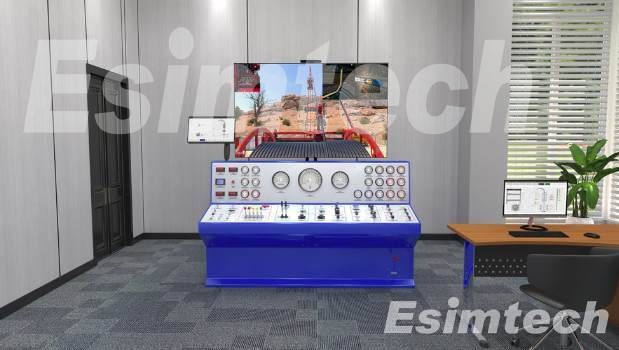More from YSmarines YSmarines
More in Politics
Related Blogs
Archives
Social Share
Why Well Intervention Simulators are Important As Advanced Training Tools in the Oil and Gas Industry
Body
Within the oil and gas industry, the deployment of well intervention simulators has emerged as a pivotal strategy for replicating the intricacies of oil and gas well interventions. These advanced training tools serve as virtual laboratories, enabling practitioners to hone their skills, master techniques, and navigate complex procedures within a secure and controlled environment.

The Significance of Well Intervention Simulators in the Oil and Gas Industry
The integration of well intervention simulators holds profound importance in the oil and gas industry, primarily due to their provision of a secure and controlled training platform. These simulators facilitate practical exposure to intricate well intervention scenarios without subjecting participants to the inherent hazards and financial ramifications of real-world operations.
A key advantage of well intervention simulators lies in their potential to elevate industry safety standards. By affording a lifelike emulation of well intervention situations, personnel can acquire the necessary competencies to execute their tasks both competently and safely. This proactive approach diminishes the likelihood of accidents and incidents that can exert substantial tolls on both personnel and the environment.
Moreover, the application of well intervention simulators can substantially curtail downtime and expenditures typically associated with real-world operations. Armed with refined skills nurtured in a virtual realm, personnel can expedite their tasks and optimize efficiency when dealing with actual wells. This streamlined approach reduces the temporal and monetary investments associated with well intervention undertakings, ultimately yielding notable cost savings for industry stakeholders.
Furthermore, well intervention simulators offer the potential to enhance staff skill retention and knowledge assimilation. These simulators deliver a more engaging and memorable learning experience compared to traditional training methodologies. As a result, personnel are poised to enhance their competencies and overall performance, thereby fostering superior outcomes and heightened production levels.

Diverse Types of Well Intervention Simulators
Well intervention simulators manifest in various forms, each characterized by distinct advantages and constraints. The choice of simulator is contingent upon the specific needs and requisites of the operation. Noteworthy categories of well intervention simulators encompass:
Virtual Reality Simulators
Crafting immersive 3D environments through advanced software and hardware, these simulators replicate well intervention scenarios. Participants manipulate specialized tools and controls to interact within the virtual domain.
Hardware-Based Simulators
Utilizing authentic equipment and tools, hardware-based simulators simulate well intervention procedures. Hydraulic or pneumatic systems mimic the challenges and pressures encountered during such operations.
Critical Components of Well Intervention Simulators
The architecture of well intervention simulators incorporates various integral components, collaboratively delivering an authentic simulation experience. While specific elements may vary contingent on the simulator type and intended application, the following components are commonly featured:
Computer Hardware
Encompassing physical components like computers, displays, and input devices (e.g., keyboards, mice, joysticks), computer hardware constitutes the operational nucleus of the simulator.
Software
At the core of the simulator lies the software, which engenders the simulation environment, constructs scenarios, and interfaces with users. Analysis tools for post-simulation assessment and reporting may also be encompassed.
Visualization System
The visualization system transmutes simulation scenarios into 2D or 3D renderings. Monitors, projectors, and head-mounted displays for virtual reality simulations exemplify visualization components.
Input Devices
These devices empower users to manipulate the simulated environment. They encompass specialized tools, joysticks, and other tailored input mechanisms.
Hydraulic or Pneumatic Systems
In hardware-based simulators, these systems replicate the stress and pressure dynamics encountered during well intervention tasks.
Sensors and Instrumentation
Essential for monitoring and recording simulation data (e.g., forces, pressures), sensors and instrumentation play a crucial role in the simulator's functionality.
Data Acquisition and Storage
This facet collates and archives simulation data, facilitating post-simulation analysis and reporting.
Power Systems
Certain simulators, particularly those reliant on hydraulic or pneumatic power, necessitate dedicated power systems for optimal performance.

Challenges Confronting Well Intervention Simulators
Development and Maintenance Costs
Creating and sustaining effective simulators can be economically demanding, particularly when specialized hardware and software are requisite.
Limited Availability of Specialized Simulators
A dearth of comprehensive well intervention simulators on the market, especially tailored to specific needs, can pose challenges for businesses in identifying appropriate options.
Limited Access to Real-World Data for Simulation Models
The accuracy and efficacy of simulation models hinge on the caliber of data employed. Securing real-world data for these models can be intricate due to proprietary concerns.
Complexity of Well Intervention Scenarios
Accurately simulating multifaceted well intervention scenarios is intricate, as factors like wellbore geometry, formation attributes, and downhole equipment interplay to shape simulation accuracy.
Conclusion
The integration of well intervention simulators is important, facilitating secure and efficient personnel training, risk evaluation, and well intervention optimization. By furnishing a virtual realm that mirrors real-world circumstances, these simulators transcend conventional methodologies, augmenting industry competence and ensuring enhanced safety and efficacy in well intervention endeavors in the oil and gas industry.









Comments